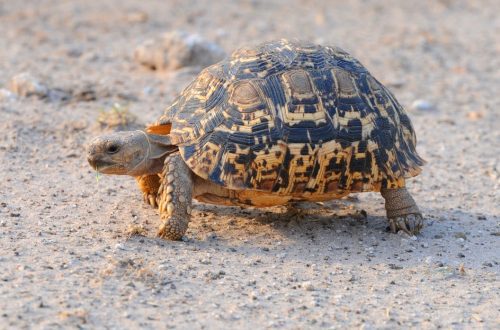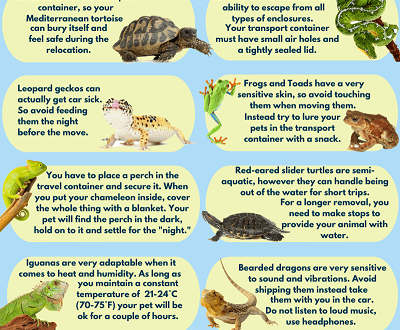
Hibernation in red-eared turtles at home: signs, causes, care (photo)
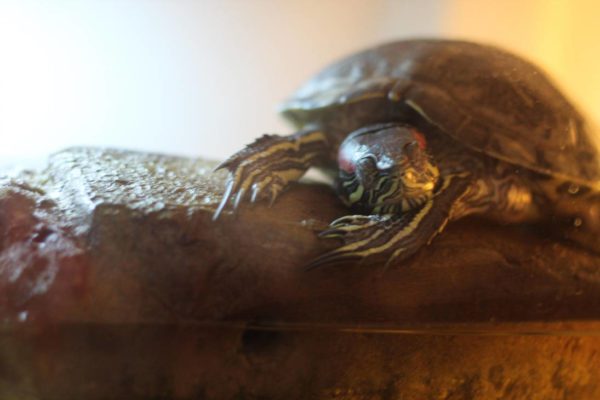
Hibernation is often confused with hibernation, a state that suppresses the vital activity of the body. Unlike anabiosis, hibernation is a natural process characterized by a more superficial suppression of general activity and internal processes.
Let’s figure out how hibernation proceeds in red-eared turtles and by what signs it can be determined.
Contents
Duration and causes of hibernation in the wild
Aquatic turtles hibernate (wintering) at too low temperatures, falling below 15 ° and remaining at this level for a long time. The reptile goes underground and sleeps until the temperature rises in a dug hole.
IMPORTANT! Sea turtles and freshwater turtles usually burrow into sand or silt to hide from the ice that has formed. When living in warmer conditions, the need for wintering disappears, but too high a temperature can cause summer hibernation.
Red-eared turtles hibernate with the advent of winter and do not emerge from it until the beginning of spring. Their sleep lasts from 4 to 6 months and depends on the size of the reptile. The smaller the turtle, the more time it needs to sleep.
Features of hibernation of domestic turtles
Indoor red-eared turtles hibernate only on rare occasions. This condition is noted in single individuals or is achieved artificially due to manipulations by the owner.
Turtles hibernate at low temperatures, so comfortable conditions of keeping at the optimum temperature eliminate this need. Due to the reduction of daylight hours in winter, reptiles sleep more than usual, but do not lose activity.
IMPORTANT! A wild turtle, brought into the house shortly before falling asleep, can fall into hibernation. In this case, the animal does not have time to adapt to new living conditions.
If you try to lull the turtle at home, you may encounter the following problems:
- Humidity and temperature deviation. Too low values can lead to the death of the pet.
- Insect penetration. Intruders entering the wintering area can damage the sleeping turtle.
- Deterioration. Hibernation takes a lot of resources from the body, so sick animals are at risk of complications.
hibernation signs
The state of wintering is often confused with death. To calm the soul, check the red-eared turtle for several points, allowing you to understand that it has definitely hibernated:
- Jaws. Try to pull your lower jaw down and leave your mouth open. The reptile should try to close its jaws.
- Eyes. A cold metal spoon leaning against the pet’s eye should trigger the corneal reflex. If the turtle tries to retract the disturbed organ or opens its eyelids, then there is no reason for concern.
- reaction to heat. A red-eared turtle in hibernation, placed in a container of warm water (30 °), will begin to move with its paws.
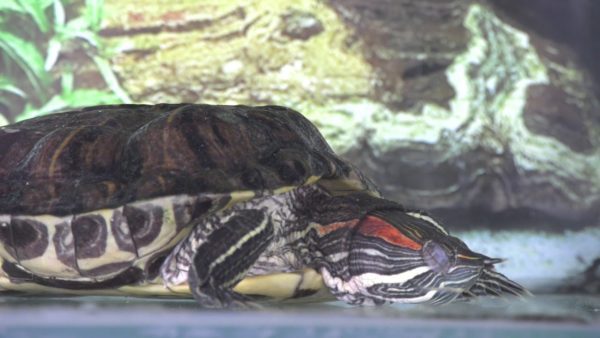
Otherwise, signs of hibernation include:
- Decreased activity. The pet behaves sluggishly, hides in the corner of the aquarium, keeping still, and refuses to leave his house for a walk.
- poor appetite. In addition to losing activity, the reptile refuses to eat its favorite food and reduces the usual amount of food.
- Increasing sleep duration. Long periods of rest are accompanied by frequent yawning.
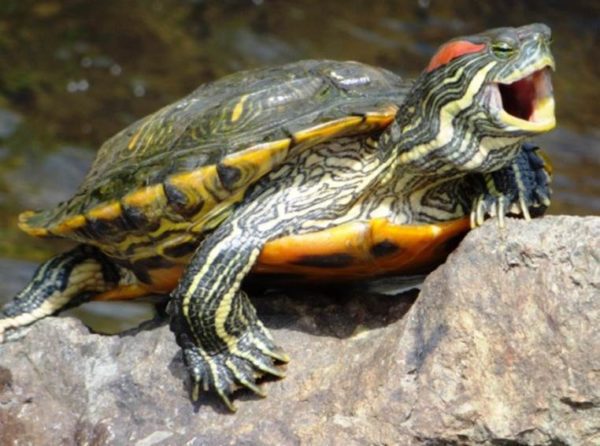
Sleeping Turtle Care Instructions
When you find the first signs of an upcoming wintering in a red-eared turtle, be sure to consult a veterinarian who will examine it and tell you what to do if the reptile really hibernates.
During the winter, follow these recommendations:
- Lower the water level. The turtle burrows into the ground, where it can sleep for a long time without rising to the surface. Obtaining oxygen is carried out by special membranes in the cloaca and oral cavity.
- Turn off auxiliary lighting. The pet will have to go to the bottom to keep warm, so turn off the filtration and monitor the water level. Excess movement will destroy the thermal layer, and a low water level will lead to freezing to the very bottom.
- Avoid feeding. Thanks to slow digestion, the turtle digests the food eaten the day before for several months.
- Monitor your pet’s health. Domestic turtles fall asleep already in November, when daylight hours are reduced, and sleep for about 4 months. It happens that the reptile does not wake up in February. In this case, you have to wake the pet yourself.
If the turtle looks active or February has come, then gradually increase the temperature and light to normal. The recovery period takes from 5 to 7 days.
You can feed your pet only after the return of the usual activity, but not earlier than the 5th day.
IMPORTANT! After wintering is over, take your pet to the veterinary clinic for examination. The doctor will determine possible complications and prescribe timely treatment if necessary.
The feasibility of artificial hibernation and preparation rules
The state of wintering has a positive effect on the reproductive system of reptiles, so experienced breeders involved in breeding send their pets to hibernation on their own.
IMPORTANT! With insufficient experience and the absence of a good reason, it is not recommended to introduce a turtle into a state of hibernation, since caring for it at home is very problematic.
Preparation for hibernation includes the following steps:
- Increase the size of the diet 2 months before falling asleep. During wintering, turtles do not eat and lose almost half their weight. Without a layer of fat, a supply of nutrients and vitamins, the animal may die.
- Cancellation of feeding 1 week before wintering. Additionally, the water level drops.
- Smooth decrease in temperature within 10 days. Turtles show lethargy at temperatures below 15 °, and at temperatures below 10 ° they go into hibernation.
- Gradual reduction of daylight hours over 10 days. Shorten lamp hours, turn off filters, and increase room humidity.
- Bathe your reptile on the last day before hibernation. A bath of warm water will help you relax and empty your bowels.
IMPORTANT! Check the sleeping turtle every 3 days and spray the soil with water to keep it moist.
Remember that during hibernation it is prohibited:
- wake up and re-lay the pet;
- wake up the reptile before the increase in daylight hours;
- to carry out bathing, starting the process of urination when the shell comes into contact with water;
- continue sleep with a strong decrease in body weight (the animal loses over 10% within 1 month);
- allow long-term cooling below 0°.
In addition to the terrarium, you can use a special plastic container. Before using it, you must:
- Fill with substrate (peat, sand, moss, sphagnum) for 10-30 cm, dry leaves or decorative pieces of bark. The selected container should be well ventilated, and the substrate should remain dry even at high humidity.
- Refrigerate on a balcony, basement or refrigerator for several days.
- Place in a cool but draft-free place at a temperature between 6° and 10°. It is not necessary to warm the place of hibernation, as this can provoke an early awakening and disorientation of the animal.
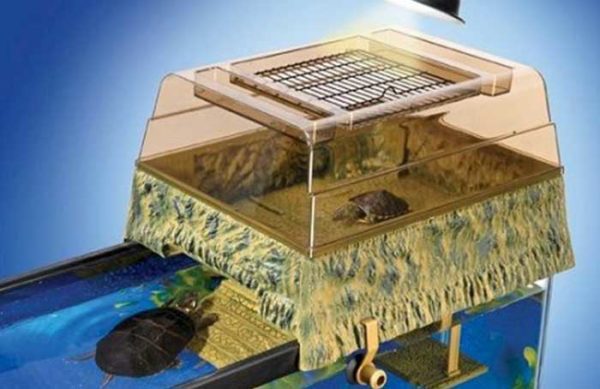
After waking up, the turtle is bathed in warm baths to restore its usual temperature and start internal processes.
IMPORTANT! If after wintering the reptile shows lethargy and looks emaciated, then consult a veterinarian to find out the cause of the symptoms.
How to avoid wintering?
To prevent the turtle from hibernating, make sure that there are optimal temperature conditions for keeping it:
- Water. The temperature should be 22°-28°. Any decrease will lead to a decrease in activity and a gradual slowdown in internal processes.
- Drought. The island is used by turtles for heating, so the temperature here can reach up to 32 °.
The reason for hibernation can be a lack of vitamins. Make sure you get enough UV or get a vitamin shot at the veterinarian. This will prevent the turtle from hibernating due to lack of nutrients.
Due to the complexity of the process and high risks, it is not recommended to introduce a reptile into a state of hibernation. If in nature the process occurs naturally and its time is determined by biological rhythms, then at home the responsibility lies solely with the owner.
How and when aquatic red-eared turtles hibernate at home
3.9 (77.56%) 41 votes




